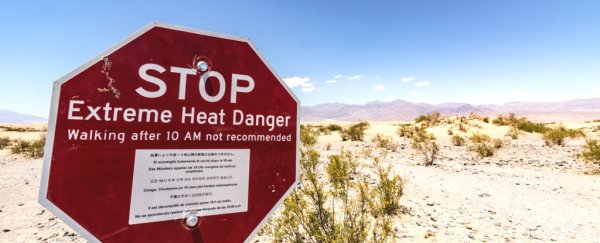Last July, California's Death Valley endured the hottest month ever measured on the planet. This July ended up even hotter.
Over both day and night, the temperature at Death Valley averaged 42.3 degrees Celsius (108.1 Fahrenheit), ahead of the mark set a year ago by about a half-degree. That previous mark had broken a record that stood for 100 years.
This year's exceptional temperature extreme at one of the planet's hottest locations puts an exclamation mark on a month in which record-high temperatures have fallen on every continent in the Northern Hemisphere.
Searing heat in Death Valley in July, is of course, the norm. So it might be hard to contemplate it being unusually hot in such a place. But this July's temperature has averaged nearly 3.5 degrees Celsius above the average of 39 (102.2 Fahrenheit).
Consider some of these incredible numbers:
- The high temperature hit at least 49 degrees Celsius (120 Fahrenheit) on 21 days, sailing past the normal high of 47 degrees Celsius (116.5 degrees Fahrenheit).
- From July 24 to 27, the high soared to 53 degrees Celsius (127 Fahrenheit) setting records on each of those four dates. This mark was not far from the location's highest reliable temperature measurement in recent decades of 54 degrees Celsius (129 Fahrenheit) set on June 30, 2013.
- The low temperature remained above 38 degrees Celsius (100 Fahrenheit) on 10 days.
The measurements come from Furnace Creek, in the heart of the valley, at 190 feet (58 metres) below sea level. It has been the official weather station for Death Valley for more than 100 years, dating back to 1911.
(Since the station is a cooperative, not officially run by the National Weather Service, there are a couple of years with missing data.)
The location famously holds the record for hottest temperature ever recorded on Earth of 57 degrees Celsius (134 Fahrenheit) on July 10, 1913.
However, that measurement is very much in question. Some climatologists believe the 54-degree Celsius (129 degree Fahrenheit) temperature logged in June 2013 is the highest temperature reliably measured there and anywhere on the planet, for that matter.
Irrespective of the legitimacy of the 1913 record, the heat this July has proved more persistent. In July 1913, one day failed to even hit 38 degrees Celsius (100 Fahrenheit), and there were also two lows of 21 degrees Celsius (70 Fahrenheit).
This year, the lowest high temperature was 45 degrees Celsius (113 Fahrenheit), and, even at night, it was never cooler than 28 degrees Celsius (82 Fahrenheit).
This year's record was first reported by Brian Brettschneider, a climate researcher at the University of Alaska at Fairbanks and contributor at Forbes.
While Death Valley presents the starkest of the records that are about to fall for July, it's not alone. This month, much of the United States west of the Continental Divide has baked.
Several locations registered their hottest Julys and, in some cases, hottest month ever recorded.
Reno, Nevada and Palm Springs, California, set new monthly temperature records. Many more spots finished in the top five or top 10, including Redding, California, where the deadly Carr Fire continues to burn, Seattle and Portland, Oregon.
Down the coast, San Francisco has been slightly less hot, but Southern California cities like Los Angeles and San Diego posted top-five hottest Julys, as well.
Why all the extreme heat? Stubborn high-pressure has dominated much of the country in the spring and summer.
During July, one of the cores of this heat dome migrated west. That opened the door for copious East Coast rain. Opposing coasts often have opposite weather. And in this case, the West Coast has torched.
This pattern is expected to continue into at least the first week of August, although temporary relief may eventually arrive in the Pacific Northwest.
Looking beyond that, dry and abnormally hot weather is likely to be the story for most of the rest of summer as eyes start to turn to a developing El Niño for real relief as fall settles in.
Death Valley's hottest recorded month on the planet adds to many other exceptional heat extremes set since late June around the Northern Hemisphere. Below is a brief summary:
- In North America: Multiple locations in Southern California; Denver; Montreal; Mount Washington, N.H.; and Burlington, Vt.
- In Europe: Multiple locations in Norway, Finland and Sweden; Glasgow, Scotland; Shannon, Ireland; Belfast and Castlederg, Northern Ireland; Amsterdam and Rotterdam in the Netherlands; Copenhagen in Denmark.
- In Eurasia: Multiple locations in central and eastern Russia; Tbilisi, Georgia; and Yerevan, Armenia.
- In the Middle East: Quriyat, Oman, which posted the world's hottest low temperature ever recorded on June 28: 42.6 degrees Celsius (109 Fahrenheit).
- In Africa: Ouargla, Algeria, which may have posted the highest temperature in Algeria and the entire African continent on July 5: 51.3 degrees (124.3 Fahrenheit).
- In Asia: Japan, South Korea, and Taiwan posted their highest temperature on record.
Collectively, all of these exceptional heat milestones are consistent with what is expected in a warming world, as concentrations of greenhouse gases from human activity continue to accumulate.
All referenced data is via xmACIS2 and the Southeast Regional Climate Center.
Note: Weather Underground's Category 6 blog states that while Death Valley's monthly temperature was hottest in US history, that Dehloran, Iran had a higher average temperature in July 2000, of 42.5 degrees Celsius (108.5 Fahrenheit).
Brettschneider, however, is unconvinced this measurement is reliable because nearby weather stations were not as hot.
2018 © The Washington Post
This article was originally published by The Washington Post.
